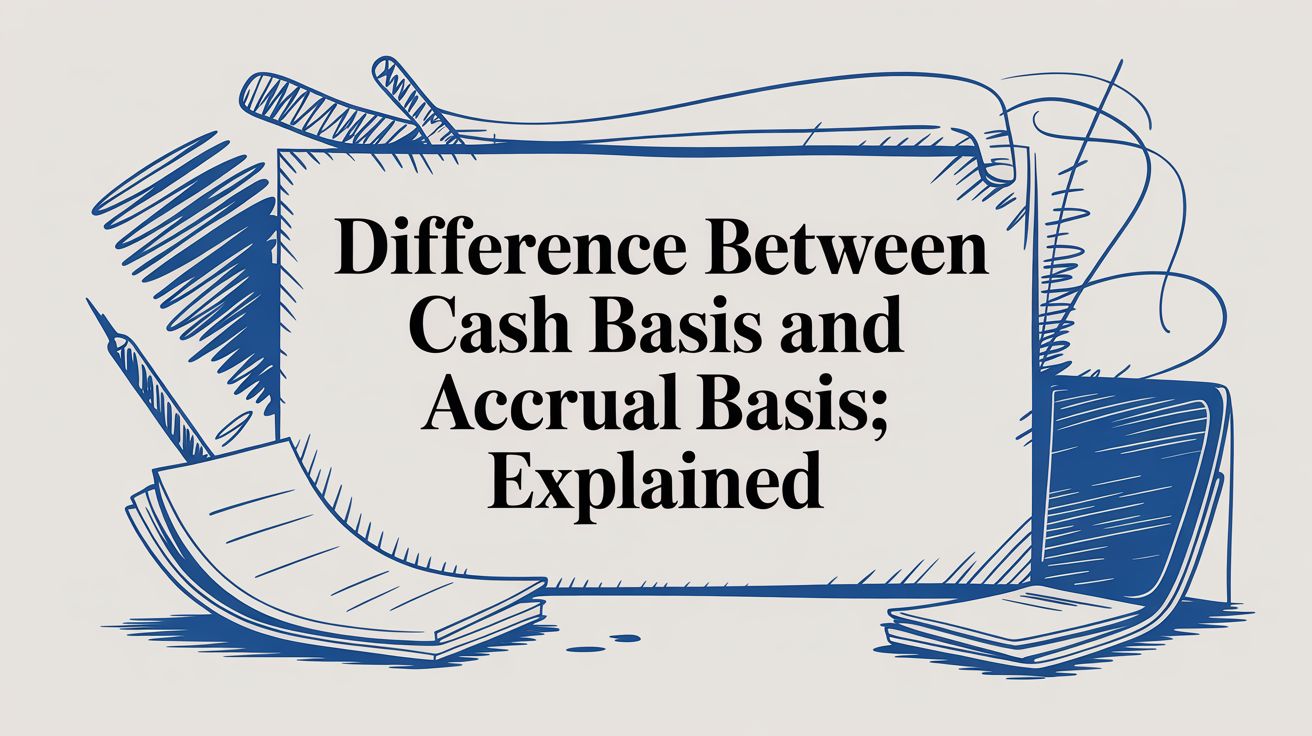
Bookkeeping Basics for Small Business Owners
Mastering bookkeeping is the first real step you take toward building a financially sound and scalable business. At its core, it’s just the process of recording every financial transaction—every sale, every expense, every payment—to create an honest picture of your company's health. This isn't just about taxes; it's the foundation for smart decisions and managing your cash flow without sleepless nights.
Why Bookkeeping Is Your Business Superpower

Let's be honest, bookkeeping usually feels like a chore. It’s that tedious task on an already overflowing to-do list. But what if you started seeing it not as an obligation, but as the single most powerful tool you have for growing your company? Think of your books as the captain's log for your business journey. Without it, you’re just sailing blind, reacting to storms as they hit instead of navigating around them.
This guide is here to reframe bookkeeping from a necessary evil into the essential language of your business. When you learn to speak this language, you gain the confidence to make sharp, data-driven decisions every single day.
The Real Cost of Not Knowing Your Numbers
So many entrepreneurs jump headfirst into their passion without a solid grasp on the financial side, a mistake that can have devastating consequences. A recent survey revealed that a staggering 60% of small business owners don't feel knowledgeable about accounting and bookkeeping. That’s a massive problem, especially when you learn that 82% of small businesses that fail do so because of poor cash flow management—an issue that good bookkeeping directly solves. You can dive deeper into these accounting and bookkeeping statistics to see the full picture.
Good bookkeeping is more than just compliance; it's your early warning system. It tells you when to spend, when to save, and when to pivot, giving you the control needed to build a resilient company.
To put it simply, good bookkeeping isn't just about keeping records; it's about building a strong, sustainable business. It provides the clarity and control you need to turn your vision into a profitable reality.
Here's a quick look at the core functions that make up a solid bookkeeping system.
The Four Pillars of Small Business Bookkeeping
| Pillar | What It Means | Why It Matters for Your Business |
|---|---|---|
| Transaction Recording | Accurately logging all income and expenses as they happen. | This creates the raw data for all your financial reports. Without it, you're making decisions based on guesswork. |
| Bank Reconciliation | Matching your internal records to your bank statements to catch discrepancies. | It ensures your cash balance is accurate, prevents fraud, and catches costly bank errors before they snowball. |
| Financial Reporting | Generating key statements like the Profit & Loss and Balance Sheet. | These reports are your business's report card. They tell you if you're profitable, what you own, and what you owe. |
| Compliance & Tax Prep | Keeping organized records ready for tax season and any potential audits. | It makes tax filing a breeze, helps you claim every possible deduction, and keeps you on the right side of the IRS. |
These four pillars work together to provide a complete and reliable view of your financial health, empowering you to make strategic moves with confidence.
What You Will Learn in This Guide
This guide is built to give you the financial clarity needed to steer your business toward its goals. We'll build your understanding from the ground up, moving from fundamental concepts to practical, actionable insights.
Here’s a roadmap of what’s ahead:
- Decoding Key Terms: We’ll break down financial jargon with simple analogies so you can finally speak the language of your finances with confidence.
- Building a Reliable Workflow: You’ll get a practical, step-by-step process for creating a consistent bookkeeping habit that won’t overwhelm you.
- Choosing the Right Tools: We’ll look at different systems and software to help you find the perfect fit for your specific business needs.
- Knowing When to Get Help: We’ll highlight the clear signals that tell you it’s time to bring in an expert to help you scale.
Decoding the Language of Your Finances
Jumping into your business's finances can feel like trying to read a foreign language. The jargon seems overwhelming at first, but the core ideas are surprisingly simple once you get the hang of them. Learning these fundamentals is the first real step toward understanding the financial story your business is telling you every day.
Think of double-entry bookkeeping as a classic balancing scale. Every single transaction has to keep that scale perfectly level. It’s a simple but powerful system that ensures for every action, there's an equal and opposite reaction recorded in your books.
For example, when you buy a new laptop for your business, two things happen at once. The cash in your bank account (an asset) goes down, but your office equipment (another asset) goes up by the exact same amount. The scale stays balanced. This single principle is the bedrock of accurate financial tracking.
Organizing Your Financial World
So where does all this financial data actually go? It all gets neatly organized in your Chart of Accounts. Just imagine it as the ultimate digital filing cabinet for your business finances. Instead of messy, random folders, you have specific, clearly labeled drawers for every kind of transaction.
This filing system really only has five main "drawers" that every single transaction fits into:
- Assets: This is everything your business owns that has value. Think cash in the bank, computers, or inventory on the shelves.
- Liabilities: This is everything your business owes to other people. This could be credit card debt, a business loan, or bills from suppliers.
- Equity: This is the net worth of your business. It’s simply what’s left over when you subtract all your liabilities from all your assets.
- Revenue: This is all the money your business brings in from selling your products or services.
- Expenses: This is all the money your business spends to keep the lights on—things like rent, software subscriptions, and marketing.
A well-structured Chart of Accounts is a game-changer. It transforms what could be a chaotic pile of receipts and invoices into a clear, understandable system that makes sense.
Managing Money In and Money Out
In your day-to-day operations, you're constantly dealing with money coming in and money going out. These two flows are managed through critical accounts that are easy to mix up but are actually quite different.
Here’s a simple way to remember it: Accounts Receivable is money you are expecting to receive from customers. Accounts Payable is money you are scheduled to pay to your vendors.
Accounts Receivable (AR) is basically a list of all the invoices you've sent to clients that you're still waiting on. It’s money you’ve earned but haven’t collected yet. If you finish a consulting project and send out a $2,000 invoice, that $2,000 sits in your AR until the client pays up.
On the flip side, Accounts Payable (AP) is the stack of bills your business owes. This includes invoices from suppliers, your monthly rent check, or payments due to contractors. If your graphic designer sends you a bill for $500, that amount is part of your AP until you process the payment. Keeping a close eye on both AR and AP is absolutely essential for managing your cash flow.
Building Your Step-by-Step Bookkeeping Workflow
Okay, we’ve covered the key concepts. Now it’s time to put that theory into practice. Creating a consistent bookkeeping workflow is the secret to turning what feels like a chore into a powerful business habit. A solid routine takes the guesswork out of the process, saves you from those late-night catch-up sessions, and gives you a constant, clear view of your financial health.
This isn't about becoming a CPA overnight. It’s about building a simple, repeatable process that actually fits into your schedule. The goal is to create a system that works for you, putting you back in control of your numbers.
This visual shows how all those core financial pieces fit together, illustrating the fundamental balance between what you own (assets), what you owe (liabilities), and what your business is ultimately worth (equity).

This relationship is at the heart of everything. Every single transaction you make affects this equation, which is why tracking each one accurately is so important for keeping the picture of your business's health in focus.
Your Weekly Financial Check-In
Consistency is everything in good bookkeeping. Seriously. Just setting aside one hour each week can save you a mountain of stress down the road. This weekly check-in is your opportunity to keep your records fresh and spot any small issues before they snowball.
Keep your weekly task list short and sweet:
- Record All Transactions: Pull up your business bank and credit card accounts. Go through every line item and categorize each expense and all incoming cash in your bookkeeping software.
- Review Invoices: Take a look at your Accounts Receivable. Who has paid up? Which invoices are still hanging out there? Now's the time to send a friendly reminder for any overdue payments.
- Process Bills: Now, check your Accounts Payable. Make a note of any upcoming due dates so you can pay your vendors on time, avoiding late fees and keeping those relationships strong.
The Monthly Financial Health Checkup
At the end of every month, it's time for a slightly deeper dive. We call this the month-end close. Think of it as a regular financial "health checkup" for your company. It’s your chance to double-check that everything for the month was recorded correctly before you start using that data to make big decisions.
The month-end close isn’t just about ticking a box. It’s about creating a clean, trustworthy snapshot of your performance that you can use to plan the next month with real confidence.
The most important task here is the bank reconciliation. This is simply the process of comparing your books against your official bank statement, line by line. You’re checking your work to make sure the numbers match up perfectly. This step is crucial for catching things like hidden bank fees, potential fraud, or simple data entry mistakes.
Here’s a simple checklist to guide your month-end close:
- Reconcile All Accounts: Perform a bank reconciliation for every business checking, savings, and credit card account you have.
- Review Financial Reports: Generate your three key reports: the Profit & Loss Statement, Balance Sheet, and Cash Flow Statement. Look for trends, anything that looks odd, or areas that need attention.
- Close the Books: Once you've reconciled and reviewed everything, you'll formally "close" the period in your accounting software. This locks those transactions in place, preventing accidental edits and protecting the integrity of your financial history.
2. Choosing Your Tools for Financial Clarity
The right tools can turn bookkeeping from a frustrating chore into one of your most powerful assets. While it might be tempting to track everything in a spreadsheet to save a few bucks, that approach almost always costs you more in the long run. It’s a recipe for tedious data entry, human error, and a total lack of real-time financial insight.
There's a much better way. Modern, cloud-based bookkeeping software is a genuine game-changer for small businesses, designed to simplify the entire process from start to finish. These platforms connect directly to your business bank accounts to automatically pull in transactions, which immediately cuts down on manual work and makes sure nothing slips through the cracks.
This isn’t just a passing trend; it’s the new standard for running a financially sound business. It's no surprise that a platform like QuickBooks Online now serves over 5 million users across the globe. Today, around 58% of enterprises use cloud accounting tools, a clear signal that the days of manual tracking are numbered. You can dig deeper into this industry shift in these stats on payroll and bookkeeping services.
Why Software Outperforms Spreadsheets
Dedicated software gives you a connected financial ecosystem for your business—something a simple spreadsheet could never do. It’s not just about logging transactions; it’s about getting a clear, accurate, and up-to-the-minute picture of your company's health.
Here’s where software really pulls ahead:
- Professional Invoicing: Create, send, and track professional invoices right from the platform. It makes you look more professional and helps you get paid faster.
- Automatic Bank Feeds: Your bank transactions are pulled in daily, giving you a live view of your cash flow without lifting a finger.
- Financial Reporting: Need a Profit & Loss statement or a Balance Sheet for a loan application? You can generate these critical reports with a single click.
- Scalability: As your business grows, your software grows with you. It can easily handle more complex transactions and reporting needs without breaking a sweat.
To help business owners wrap their heads around the difference, here is a direct comparison.
Manual Spreadsheets vs. Cloud Bookkeeping Software
| Feature | Manual Spreadsheets | Cloud Software (e.g., QuickBooks) |
|---|---|---|
| Transaction Entry | 100% manual data entry | Automatic import via bank feeds |
| Error Rate | High risk of typos & formula errors | Low risk, with built-in checks |
| Reporting | Manual creation, time-consuming | Instant, one-click reports (P&L, etc.) |
| Real-Time Data | Outdated the moment you close it | Always up-to-date with bank sync |
| Invoicing | Separate process (e.g., Word/Excel) | Integrated, trackable invoicing |
| Collaboration | Difficult; risk of version conflicts | Easy access for you and your accountant |
| Security | Vulnerable to file corruption or loss | Bank-level security and backups |
| Scalability | Becomes unwieldy as business grows | Scales easily with your business |
The choice becomes pretty clear when you see it side-by-side. The initial time and cost saved with a spreadsheet are quickly lost to inefficiency and potential errors.
For instance, this screenshot from QuickBooks shows how their software tiers are designed to support you at every stage, from just starting out to running a more complex operation.
This means you can start with a basic plan and simply upgrade as your needs evolve, making it an adaptable and future-proof solution.
The Power of Integration
One of the biggest wins with modern software is its ability to talk to your other business tools, especially your payroll system. When your bookkeeping software (like QuickBooks) and your payroll provider (like Gusto) are integrated, you eliminate hours of mind-numbing, redundant data entry.
Integrating your payroll and bookkeeping systems is one of the most effective ways to ensure accuracy. It automatically syncs wage payments, payroll taxes, and benefits expenses, creating a seamless and error-free record.
This simple connection prevents the kind of costly mistakes that happen all too easily when you're manually transferring numbers from one system to another.
Ultimately, choosing the right tools isn't an expense; it's a strategic investment. It gives you the accuracy you need to stay compliant, the efficiency you need to save time, and the clarity you need to make confident, informed decisions that will actually drive your business forward.
Turning Numbers into Actionable Business Insights

Keeping accurate books is just the first step. The real magic happens when you turn all that organized data into a strategic advantage for your business. Think of your financial reports not as a chore for tax season, but as a roadmap telling the story of your company—where you've been, where you are now, and where you're headed.
Learning to read this story is what separates businesses that just survive from those that truly thrive. The key is understanding three fundamental reports that answer the most critical questions you face as a business owner.
Your Business Report Card: The Three Key Statements
Imagine your financial statements as a report card for your business. Each one gives you a grade on a different subject, and when you look at them together, you get a complete picture of your financial health.
These three reports are the foundation of any solid business analysis:
- The Profit & Loss (P&L) Statement: This one answers the most direct question: Are we profitable? It lays out your revenues and expenses over a specific period—like a month or a quarter—to show your net profit or loss.
- The Balance Sheet: This answers: What is our overall financial health? It's a snapshot of your business on a single day, showing what you own (Assets), what you owe (Liabilities), and your net worth (Equity).
- The Cash Flow Statement: This tackles the crucial question: Where is our money actually going? It tracks every dollar moving in and out of your business, breaking it down into operating, investing, and financing activities.
It’s easy to see a profitable P&L and think everything is great, but you could still face a cash crunch if your clients are slow to pay. That's exactly why you need all three reports to get the full story.
Moving Beyond Raw Numbers with KPIs
To really pull out actionable insights, you have to look beyond the totals on a page and analyze the relationships between the numbers. This is where Key Performance Indicators (KPIs) come in. KPIs are specific calculations that act like vital signs, revealing the true efficiency and performance of your operations.
One of the most powerful KPIs for any business selling a product or service is the Gross Profit Margin.
Gross Profit Margin tells you what percentage of revenue is left after you've paid for the direct costs of what you sell. It’s a powerful indicator of your core profitability and pricing strategy.
Calculating it is pretty straightforward:
(Revenue - Cost of Goods Sold) / Revenue * 100
Let's say you sold $50,000 worth of products last quarter, and the materials and direct labor to make them cost $20,000. Your gross profit margin would be 60%. A healthy margin like that tells you your pricing is strong and your production is efficient. By tracking KPIs like this one, you transform bookkeeping from a simple compliance task into an essential strategic tool for growth.
Knowing When to Outsource Your Bookkeeping
When you first start out, handling your own books is a great way to get a feel for the financial pulse of your business. You get a firsthand look at every dollar coming in and going out. But as your business grows, that insightful task can quickly turn into a time-consuming chore that pulls you away from what you should be doing: running the company.
Recognizing when to pass the torch to a professional is a crucial step in scaling your business. This isn't about losing control—it’s a strategic investment to gain a new level of expertise and efficiency.
Signs It Is Time for Expert Help
The moment you find yourself spending more time categorizing receipts than talking to customers, you know you have a problem. That's a huge red flag. Other triggers might be that your transactions are getting more complex, you're getting ready for an audit, or you're just feeling uneasy about keeping up with tax rules and regulations.
Outsourcing your bookkeeping frees you to focus on what you do best—innovating and growing your business. It transforms a complex administrative task into a strategic asset managed by experts.
There's a reason this is becoming the standard approach for successful businesses. Around 78% of small businesses worldwide now outsource their bookkeeping, and the results speak for themselves. Businesses that make this smart move have been shown to grow up to 30% faster than those still managing their books in-house. You can dig deeper into the impact of outsourcing on business growth to see the numbers.
At the end of the day, bringing in a firm like Steingard Financial does more than just give you accurate records. It gives you a reliable financial partner who is genuinely invested in your success.
Common Questions New Business Owners Ask
As you get the hang of things, you'll inevitably run into a few questions. It happens to everyone. Let's tackle some of the most common ones we hear from founders just starting out.
What Is the Difference Between Bookkeeping and Accounting?
It’s easy to get these two mixed up, but the distinction is pretty important.
Think of it like this: your bookkeeper is the one on the ground, carefully recording every single financial move your business makes. Every sale, every invoice paid, every supply order—they're meticulously logging it all. This is the day-to-day work of building a clean, accurate financial history.
An accountant then takes that history and tells you what it all means. They step back to see the bigger picture, preparing your financial statements, filing taxes, and offering strategic advice based on the numbers. One builds the foundation, and the other builds the skyscraper on top of it.
Can I Do My Own Bookkeeping?
Yes, you absolutely can. In fact, most business owners start out doing it themselves. With great software available today, it’s never been more manageable for a founder to handle their own books, and it’s a fantastic way to get intimately familiar with the flow of money in your company.
The real question is, for how long should you do it? As your business scales, so does the complexity. More customers, more invoices, maybe a few employees—suddenly, you’re spending hours every week on tasks that aren't generating revenue. That's the tipping point. Recognizing when your time is better spent on strategy and growth rather than data entry is a key moment in any business's journey.
Smart founders know how to delegate. Outsourcing your bookkeeping isn't giving up control; it's buying back your time to focus on what you do best—running your business.
How Often Should I Update My Books?
If you take only one thing away from this, let it be this: consistency is everything.
At a bare minimum, you need to be closing out your books every month. But if you want to run your business with clarity and confidence, a weekly routine is the gold standard.
Just an hour or two set aside each week can make a world of difference. Here's why:
- You’ll always know where you stand financially. No surprises.
- Catching a small error is easy. Fixing a mistake from six months ago is a nightmare.
- You can say goodbye to that end-of-the-month panic to get everything organized.
- It gives you a real-time pulse on your cash flow, which is crucial for making smart decisions on the fly.
Ready to gain a trusted financial partner who can handle the details so you can focus on growth? Steingard Financial offers expert bookkeeping and payroll services to give you peace of mind and actionable insights. Learn how we can help your business thrive.
Article created using Outrank






